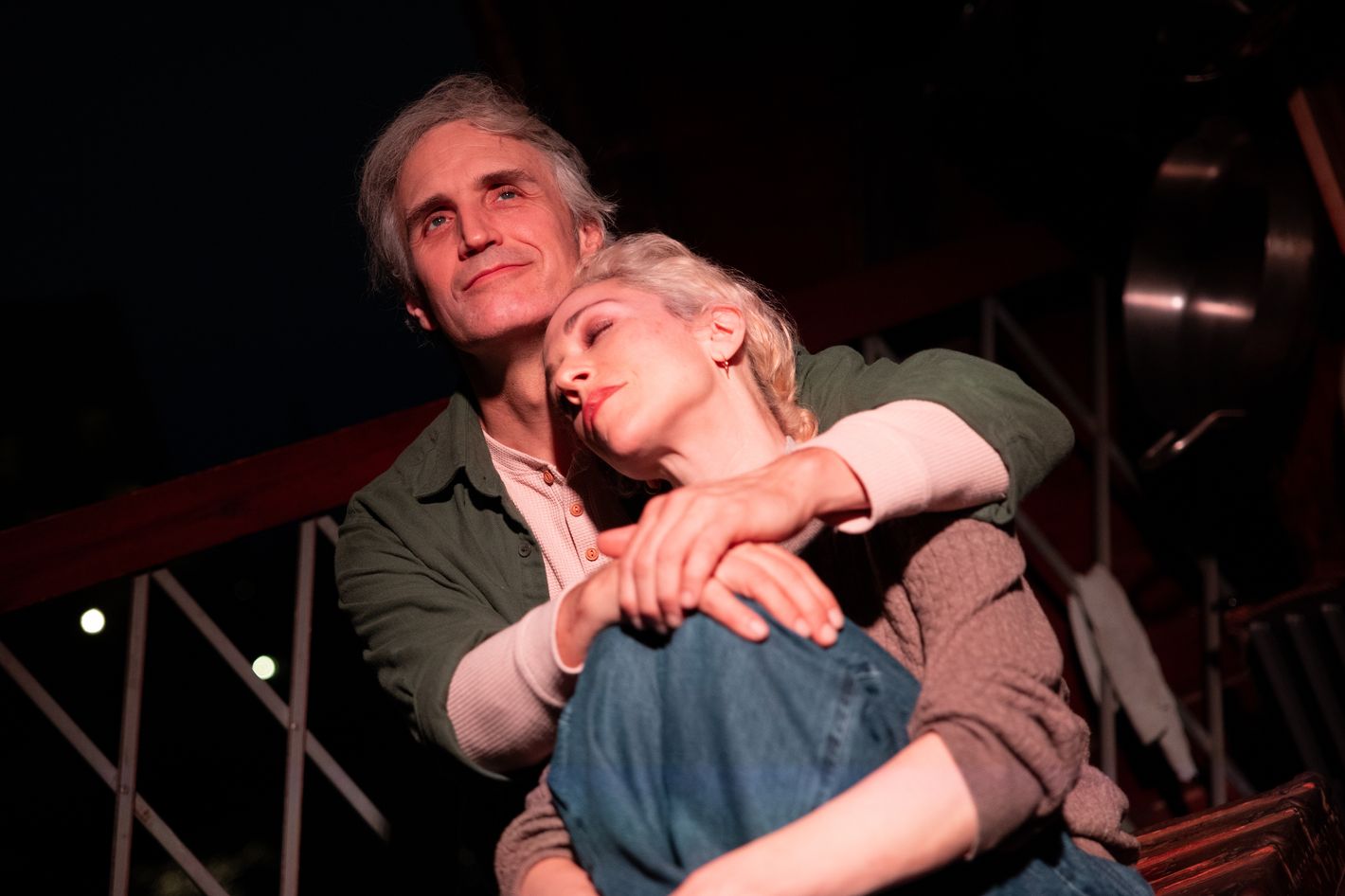Drama Afloat in Red Hook: The Wind and the Rain
A play about Sunny’s Bar and the world it embodies.


The playwright Sarah Gancher has a gift for invoking theater’s extraordinary power of simultaneity. On the stage, many times can coexist, and many places — they can sit side by side and we can hop between them, or, richer still, they can lie atop one other, like archaeological strata or translucencies that bring together a composite image. “Here’s what Einstein thought,” says an audience member at Gancher’s exquisite new play, The Wind and the Rain, reading from a text that’s been handed to them by an actor. “Space and time are the same thing. Just like I’m here now, but I could be in Hawaii. And Hawaii exists. I’m here now, but I could be 300 years in the future. And somehow that exists too, even though I am currently surrounded by now … Einstein thought that in the Big Bang, not just all space but all time was created.”
I’m here now, at my desk, but there’s also an I that’s still on the barge that houses Red Hook’s Waterfront Museum, where The Wind and the Rain is performed; another I is sitting in the Traverse Theatre in Edinburgh in 2011, watching a play called Mission Drift that Sarah Gancher created with the TEAM. That I was also there on the boat as this new play unfolded — and for all of us, all three, the heart swells in the chest. For in both plays, Gancher sends a plumb line down through history and a flare up into the future. Both pieces fill the here and now, as the spark illuminates the filament with a glowing, pulsing sense of the infinite present. For Gancher, the theatrical moment stretches to encompass all moments past and to come, vibrating with beauty, urgency, and potential.
A brief interlude: God bless companies like En Garde Arts, which is producing The Wind and the Rain in association with Vineyard Theatre, and whose founder, Anne Hamburger, asked Gancher for “the biggest, most ambitious site-specific piece that you’ve ever imagined, but never written, because you thought nobody would ever produce it” (so writes Gancher in the show’s program). That, friends, is how art this good gets made: real trust and investment in big, weird, specific, local ideas. Curiosity. Running screaming from the safe middle, which never turns out to be all that safe after all.
Gancher’s ambitious site-specific piece has a subtitle — “A Story About Sunny’s Bar” — and therein lies its touchstone, the pitch pipe she uses to start composing its harmonies. As you walk down Conover Street, toward the water and the Waterfront Museum, you pass the real Sunny’s — a brick building, an unassuming green awning, a rusty neon BAR sign, and an even rustier pickup permanently parked out front. The place has been around for over a century and has been run the whole time by the Balzano family, notably the garrulous, charismatic philosopher king, Sunny Balzano, who died in 2016. (Here, Sunny is embodied by Pete Simpson, who just couldn’t be better.) As The Wind and the Rain reveals, though, it would be more accurate to say that Sunny’s wife, Tone Johansen (played with heartbreaking restraint by Jen Tullock), ran things, as she still runs them today. Tone, a sculptor and musician who came from Norway on an artistic grant in the ’90s (her name is pronounced “tuna”), met Sunny when Red Hook was still “desolate, burnt out,” says Jennifer Regan, one of the show’s five storytellers who assume various roles in the moment. “The streetlights didn’t work. A pack of wild dogs lived on Beard Street.” Flashing his irresistible smile, Simpson’s Sunny warns Tullock’s Tone that she better not be out on foot after dark: “If you’re on a bike and you run into the dogs, you can outrun them. Worst comes to worst, throw the bike at them.”
Later in the show, as the neighborhood around Sunny’s shifts and shifts again, another audience member is given a line to say (the show’s audience participation is unpretentious, unforced, and integral): “I saw a dog wearing a cashmere sweater.” So much for wildness — but not for danger. Myriad forces swirl through Gancher’s play, and the literal tempest of its title — thrown into such terrible focus in the aftermath of Helene and Milton — blows alongside other gales, equally implacable and equally traceable straight back to human avarice. “We are ending and ending and ending our world,” Gancher writes. “All because of money: A fiction that is eating the planet.” The ache that rises like its own waterline as The Wind and the Rain delves deeper and deeper into the patch of earth we’re sitting on isn’t about nostalgia: The show compellingly evokes the days when longshoremen rubbed shoulders with mobsters at Sunny’s counter — and the Feds prowled Red Hook on the lookout for homemade wine and moonshine (the Balzanos produced both) — without valorizing them as somehow better times. And it’s not that there’s something inherently evil about the Red Hook of vegan pizza, craft breweries, and Ikea. But all you have to do is open Zillow to know that something is broken, and not accidentally so. The Four Horsemen of the Apocalypse aren’t just warlords; they’re landlords.
The particular doomsday with which The Wind and the Rain is concerned is, of course, Hurricane Sandy — yet a great part of the play’s potency lies in the richness and density of its echoes. The world has ended in this place before, when the glaciers melted, when the Dutch slaughtered the indigenous Wickquasgeck people, when the English displaced the Dutch. It will happen again. “When the flood comes,” says Regan, “memories lift up and float.” It’s a breathtaking image: In the stretches of the show that occur during Sandy, Tullock enacts lurching through waist-high water on the first floor of the bar as Tone tries to rescue photographs from the deluge. Gancher uses the photos as portals, vaulting in and out of ancestral stories, conjuring the souls that cling to Sunny’s walls, even as everything seems to be slipping away. We see Sunny’s grandparents, Antonio Balzano, who arrived from Calabria in 1888, and his wife Angelina, who came through Ellis Island in 1896 when she was 20 years old. There’s the charming, philandering bartender Romeo and his sharp, suffering wife Teresa, not Balzanos but family enough to manage the bar during Sunny’s boyhood. Here are Sunny’s siblings, Frankie and Rose — the former immortalized along with Sunny in a fuzzy photo from 1944, leaping off a Red Hook dock in their underwear. Rose was not allowed to join.
Just as she loops and layers moments in time, so Gancher also interweaves fact and the freedoms of fiction. Much of The Wind and the Rain is based on interviews — Gancher, a fiddler, is a regular at the folk-music jam sessions that have become legendary at Sunny’s over the years, and she knows the real Tone well. But the show isn’t a documentary. It wants to pluck the strings of larger ideas and resonant parallels. So many adventurous boys, so many impulsive, magnetic, beautiful men — friends to all, lovers to as many as possible. And so many women who have been there keeping the walls from falling. Along with Simpson, who also plays Romeo, and Tullock, who doubles as Angelina, Regan and Paco Tolson form a quartet of domestic complexity across time: Like Sunny, Tolson’s Antonio is a dreamer, happy to let his wife do the taxes. Like Regan’s stricken Teresa, Tone watches her husband make love to everyone (“It’s a bartender’s job to flirt!” Sunny insists), while only she knows the flip side of his glamour, the pits of narcissistic despair in which he’s apt to sink. During the hurricane, Sunny — older than Tone and in remission from cancer, though he’s mixing his meds with nicotine and booze — practically turns to stone. It’s chilling to watch Simpson curl up a table, all his easygoing radiance drained away, while Tullock’s Tone staggers around in the dark, trying to muck out the bar, call someone, anyone, for a generator, deal with horrible relatives from Jersey who want them to sell, and take care of a baby. “I don’t know what you want me to do,” Sunny tells her, poison in his voice. “I’m not Mr. Mundane Details … I’m a poet and to me, this is grief! This is grief! I can’t help.” How can Tone still love this man? How can we? It’s proof of both the nuance in Gancher’s script and the heart in Simpson and Tullock’s performances that we know the answer, even if it’s inarticulable.
Most of The Wind and the Rain unfolds in the snug, lantern-lit interior of the Waterfront Museum barge, with the playful, free-flowing energy of one of the bar’s own jam sessions. (Different local bands, all frequenters of the jams, play preshow music every night, and Pete Lanctot rounds out the cast as resident musician.) But in the show’s final moments, director Jared Mezzocchi shifts ground. Mezzocchi is also known as a projection designer and multimedia artist, and though Paul Deziel designed the projections here, you can tell that Wind’s director has been itching to add a digital layer or two to the show’s erstwhile scrappy palimpsest. It’s a stylistic gamble that pays off: Gancher has already crammed so much within this wooden barge, and now Mezzocchi takes us out into the chilly Red Hook night, at once expanding the circumference of the production’s conjuring circle and allowing its magic to diffuse, as all things must. I won’t give away the show’s lush final gestures in their entirety, but there is a moment in which the audience is walking together past a row of cargo containers. Deziel has a projector stashed across the parking lot from these containers, and as we pass by, ghostly silhouettes walk in tandem with us along their corrugated surfaces. We are, for a moment, in stride with our ancestors and fully aware of their presence.
There is a now that is a set of fleeting, gorgeous moments in October, in which a play about a bar is unfolding at the end of a Red Hook dock. There is a now when that bar was underwater, when a woman from Norway was fighting with everything she had to save it. There is a now when two boys were leaping from a dock — this very one? — in their underwear. The rain, it raineth every day — not because the sun never shines, but because somewhere, in someone’s now, the storm has already come. Without admonishment or accusation, The Wind and the Rain offers us the gift of responsibility. Whether we can sing in harmony with the future depends on what we do today, what we love, and what we save.
The Wind and the Rain is at the Waterfront Museum in Red Hook through October 27.
Related








